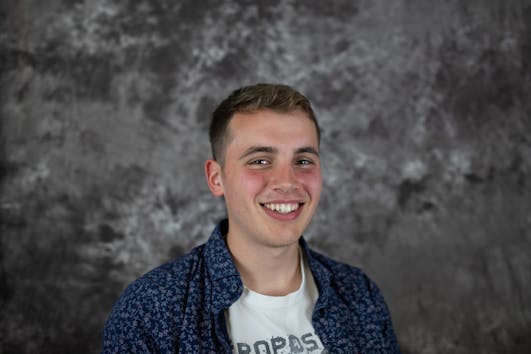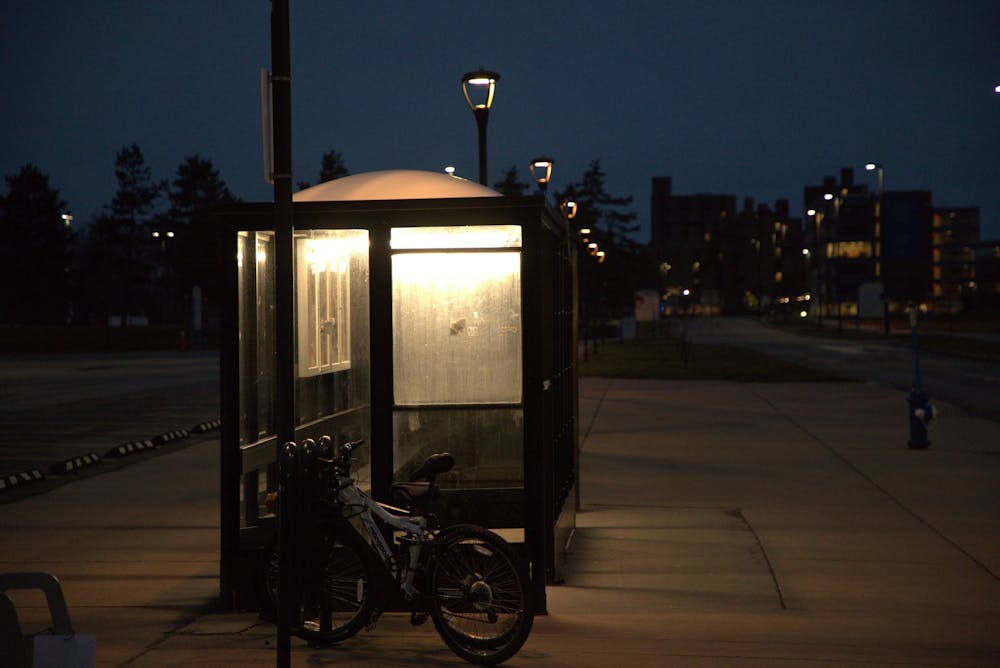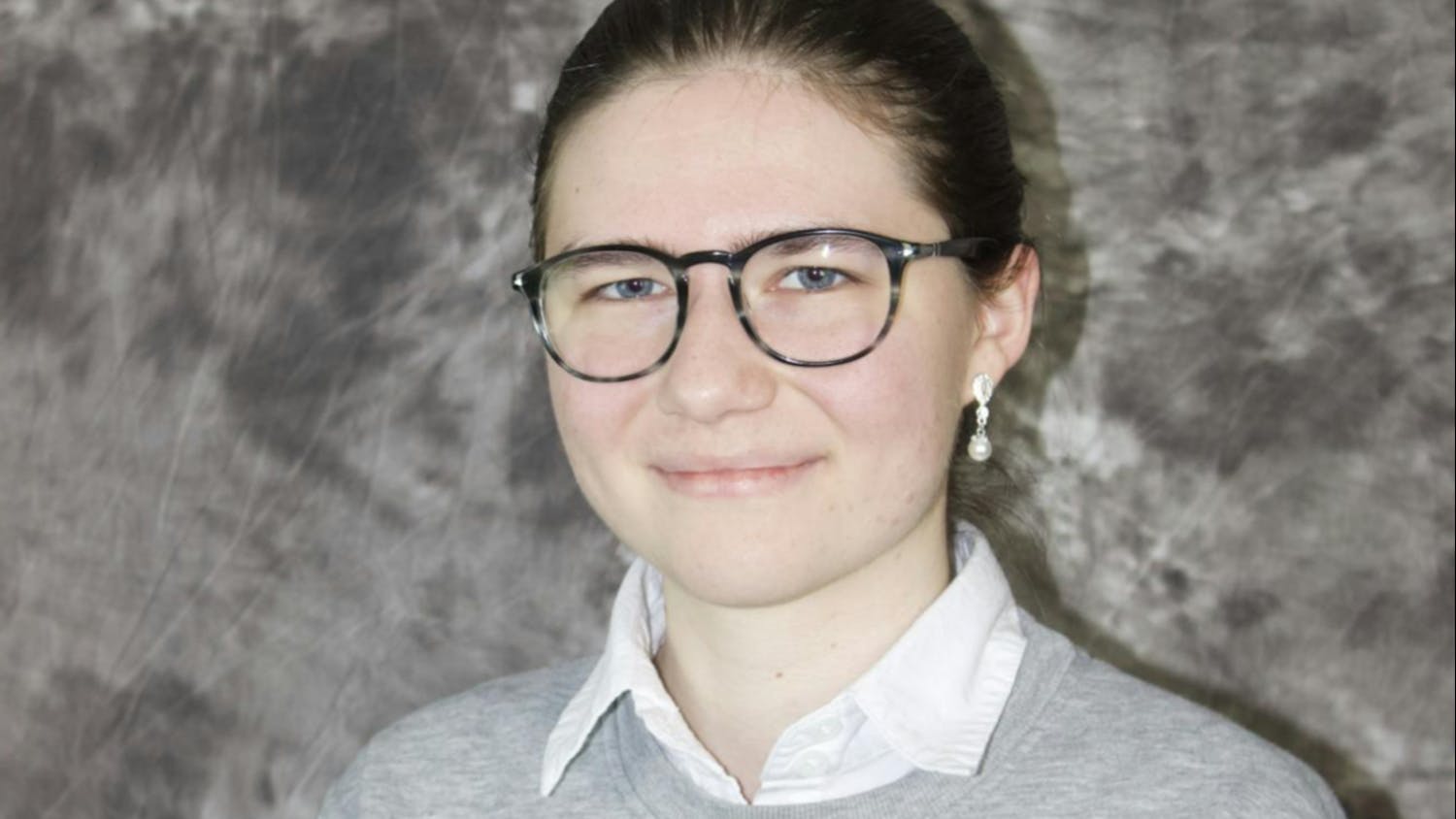Members of the UB community are split on whether the university’s handling of the COVID-19 pandemic during the fall semester was “successful” or “inexcusable.” Either way, the university returned to hybrid learning for the spring semester on Monday.
UB’s campus reopening comes at a time when the highly contagious U.K. variant of the virus is circulating in neighboring Niagara County and just a few months after the university exceeded the SUNY threshold for shutdown (something the school did not do). UB has taken a number of steps to mitigate these factors, but union leaders and the UB student representative complain they didn’t have large enough of a seat at the table.
“The university thinks that it's done a fantastic job of dealing with COVID,” Lawrence Mullen, an English Ph.D. student and business agent for the Graduate Student Employees Union, said. “They didn't really learn from that and they're still going to move forward anyway.”
For the second straight semester, testing is at the crux of the debate over the university’s decision to reopen campus.
To combat the surrounding conditions and stave off a campus-wide shutdown, the university is implementing new COVID-related restrictions. Before arriving on campus, students are required to complete 14 days of daily health checks and maintain a week-long quarantine. Students are also obligated to take a COVID test before coming to campus or use the university’s pooled saliva tests in the days after their arrival.
Additionally, UB will follow a mandate from SUNY Chancellor Jim Malatras which orders all on-campus students, faculty and staff to be tested weekly for COVID-19.
Weekly surveillance testing will allow the university to “be able to closely monitor the prevalence of COVID-19 within the UB community, make timely decisions on interventions and identify potential hotspots in order to stop clusters of outbreaks before they occur,” UB Spokesperson John DellaContrada said in a statement.
This testing regiment stands in stark contrast to last semester, when the university conducted anywhere from 327 to 8,228 tests per week.
The university’s baseline and weekly surveillance testing of all on-campus UB community members has received wide support.
“I think there’s going to be fewer cases at the beginning because of the baseline testing and the quarantining, to the extent that people do that,” said Dr. Phil Glick, a professor of surgery and management at the Jacobs School of Medicine and president of the Buffalo Health Sciences Chapter for the United University Professions, the union that represents SUNY faculty and staff.
UB came dangerously close to shuttering on-campus operations in the first few weeks of the fall semester; 71 on-campus cases counted toward UB’s threshold during the first two-week period, with another 76 cases counted during the following period. By requiring all on-campus students to take a baseline test around the time classes begin, SUNY hopes to prevent another surge during the first month of the semester.
Glick would prefer each student to receive two baseline tests to root out false negatives, but he is hopeful that UB’s rigorous testing program will keep cases down.
“If people realize that they’re gonna be tested on a weekly basis, maybe they will think twice about going to a party,” Glick said.
Michael Montoro, the UB Council’s student representative, called the new testing regiment “really important,” but argued it should have been implemented sooner.
“It’s obvious now in hindsight that we should have been doing that [level of baseline and surveillance testing] in the fall,” Montoro said. “When this question came up back in the fall, there was a question of who’s going to pay for it. And now that there's a SUNY mandate, there doesn’t seem to be any questions about the money anymore.”
DellaContrada disputed Montoro’s claims.
“We did implement surveillance testing at the beginning of the fall semester immediately when it became available with SUNY Upstate in September,” DellaContrada said, adding that Montoro’s comments are “not an accurate characterization.”
But some members of the UB community believe the university still isn’t doing enough to ensure a safe return.
“I don’t think necessarily that the quarantine and testing policies that are in place for returning are adequate,” Mullen said. “Last semester, we had nearly 1,100 positive cases [including off-campus cases]. I think it’s ridiculous to think that they’ve managed that crisis well when 1,100 people still tested positive.”
DellaContrada argued that the overwhelming spread occured off-campus, especially at the start of the semester, when UB cited “smaller scale parties” in the University Heights neighborhood as contributing to the increase in cases.
“The majority of cases did not occur from spread on-campus,” DellaContrada said in a statement.
If the decision were theirs to make, Mullen would move all classes online, with only graduate-level research taking place in-person. This semester, 67% of all UB classes are remote, while the remaining 33% are in person. However, that is not a plan Mullen ever expected the university to adopt.
“That’s a structure that would require that the university take a financial loss, which they won’t do,” Mullen said.
Montoro stopped short of advocating for a completely remote spring semester but said that if the decision were up to him, “that would have been a much bigger option on the table.”
Glick, meanwhile, called the reduced on-campus population a “good strategy.”
DellaContrada said 4,510 students made reservations to live on-campus for the spring semester, making for a 60% occupancy rate. Approximately 6,000 non-residential students will attend at least one on-campus class.
Surveillance testing throughout the fall semester as well as mandatory pre-Thanksgiving testing made “very clear that the COVID-19 positivity rate of our students living off campus was much higher” than that of students living on campus, Glick said. On-campus students “seem to be more well-behaved.”
“I was very pessimistic about last semester, and I thought we were going to have to close down in three weeks,” Glick said. “So, to the extent that the plan worked, the plan worked. I was glad to see that.”
The university took credit for their response, saying that their plans successfully slowed the spread of COVID-19.
“UB’s leadership has heard from many students, faculty, staff, alumni and parents who have said UB’s administration has responded very well to the pandemic, and the university’s plans have been very well conceived and implemented,” DellaContrada said.
While the trio’s views differ on the effectiveness of UB’s plans for the spring semester, all three felt the university was exclusive and uncommunicative when crafting its reopening plans.
While graduate and undergraduate students serve on the campus planning committee and its support units, no students serve on the Screening, Testing and Contact Tracing Protocol Committee, which, according to the committee’s website, advises the Executive Committee on public health questions, “including when and how to reopen campus.”
According to Mullen, this leaves out valuable voices.
“[On] any decision that is made about COVID, or really anything in general, there needs to be graduate student representation, because graduate students are in this particularly odd position of being both students and also instructors,” Mullen said. “And that leaves us particularly vulnerable.”
DellaContrada declined to explain why the Screening, Testing and Contact Tracing Protocol Committee lacked student representation, saying only that “there are graduate students on the [other] planning committees to represent UB’s graduate students.
And that lack of graduate student representation appears to have bred some mistrust.
“There’s a lot of uneasiness from those who are teaching on campus, especially grad students who have very little leverage,” Montoro said. The university has left individual departments to decide whether and when to provide in-person instruction, making it difficult to ensure TAs’ safety and rights, according to Mullen.
The university is “limiting in-class student instruction to 25% capacity to help maintain a safe level of density on campus,” DellaContrada said.
Despite his position on the UB Council, Montoro said he feels left out of parts of the process.
“A lot of that contingency planning is not really being done publicly,” he said, referring to the university’s plans for what would happen if on-campus cases exceed the threshold set by SUNY. “It’s being done at the higher administration level with very little input by the community. It seems like the administration has contingency plans we don’t know about.”
“UB faculty, staff and students have been engaged in UB’s [contingency] planning at all times, and the university continuously gathers and considers their feedback,” DellaContrada said, who noted that contingency plans are available on the university’s website.
Union leadership also notably lacks a place on any COVID-19-related committee.
“Ultimately, there needs to be better communication between the university and all of the particular unions,” Mullen said. “And if there was a way to have that sort of meeting and be able to communicate, then we could much more effectively inform our own members as to what they should be doing.”
Mullen, for instance, found out that TAs who are teaching in-person classes this semester are eligible for a COVID-19 vaccine from the New York Department of Health website, not from the university.
“You’d think that maybe I would know that from the university that employs my [union’s] TAs, so then I could tell them, ‘go get a vaccine as soon as you can,’” they said.
Mullen is not the only union leader who felt left out of the process. Glick and the rest of the UUP have been pushing for a health and safety committee with both university and union leadership, as outlined in Article 43 of the union’s contract with SUNY, to more effectively tackle the pandemic.
“During last spring and during the summer, I asked the president [and] the provost, publicly and in writing, on several occasions, to please put Union leadership, including UUP on their COVID task force and they refused,” Glick said.
DellaContrada argues that union leadership’s membership on the university’s COVID-19-related committees is unnecessary since most faculty and staff are union members.
“University leaders and administrators are also in regular contact with the union about UB’s response to the pandemic,” DellaContrada said.
Glick said he has heard this response from the university before.
“That’s true,” Glick said. “Everyone on the faculty, almost, is a union member. 93% [are]. But rank-and-file unionists don’t have the same awareness or the same flexibility to be outspoken.”
And, according to Glick, that lack of union representation puts members of the UB community at unnecessary risk.
“In the spring and the summer when I was pounding on the tables that they need to do baseline testing and surveillance testing, the university, through their COVID task force said, ‘it's not necessary,’” Glick said. “So, if we’d been at the table from the beginning, we would have, probably, a much stronger voice.
“Has their decision-making been inclusive?” Glick said. “No. And I have to say, that it’s disappointing to me, with such a serious pandemic, that the university’s anti-union attitude would influence their decision-making. And we’re still pressing hard to have an Article 43 Health Safety Committee, and I bring it up every month at our labor management meetings with the University.”
DellaContrada believes UB’s approach has incorporated all perspectives.
“The ideas, opinions and feedback of students, faculty and staff have been prominent in all of the university’s planning,” DellaContrada said.
Grant Ashley is the assistant features editor and can be reached at grant.ashley@ubspectrum.com

Grant Ashley is the editor in chief of The Spectrum. He's also reported for NPR, WBFO, WIVB and The Buffalo News. He enjoys taking long bike rides, baking with his parents’ ingredients and recreating Bob Ross paintings in crayon. He can be found on the platform formerly known as Twitter at @Grantrashley.





